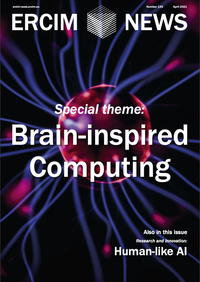Human Brain Project researchers contribute articles on neuromorphic computing to ERCIM News
28 April 2021
Human Brain Project researchers have contributed articles on neuromorphic computing to the most recent edition of ERCIM News – the official magazine of The European Research Consortium for Informatics and Mathematics (ERCIM). The ERCIM aims to foster collaborative work within the European research community and to increase co-operation with European industry.

The articles discuss the latest developments on SpiNNaker and BrainScaleS, two complementary, large-scale neuromorphic computing systems that are part of the EBRAINS research infrastructure. Neuromorphic computing refers to hardware and software that aims to mimic the structure of neural networks in the human brain. This approach seeks to make computers more energy-efficient and better at problem-solving.

The BrainScales (left) and SpiNNaker (right) neuromorphic computing systems
In his article ‘Building Brains’ (page 12), Steven Furber from the University of Manchester gives an overview of SpiNNaker, the world’s largest neuromorphic computing system. He also gives readers an idea of what to expect from SpiNNaker 2 – the successor to the current SpiNNaker machine – which is under development as a collaboration between the University of Manchester and the Technical University of Dresden.
Johannes Schemmel, from the University of Heidelberg, introduces the BrainScaleS system in his piece, ‘The BrainScaleS Accelerated Analogue Neuromorphic Architecture’ (page 14). In the article that follows, Andreas Baumbach, Sebastian Billaudelle, and Mihai A. Petrovici – also from the University of Heidelberg – highlight the versatile capabilities of the BrainScaleS architecture, which aims to support a wide range of users from the neuroscientific research community and industry (page 15).
Read the latest edition of ERCIM News, ‘Special theme: Brain-inspired Computing’, here.
Further information



